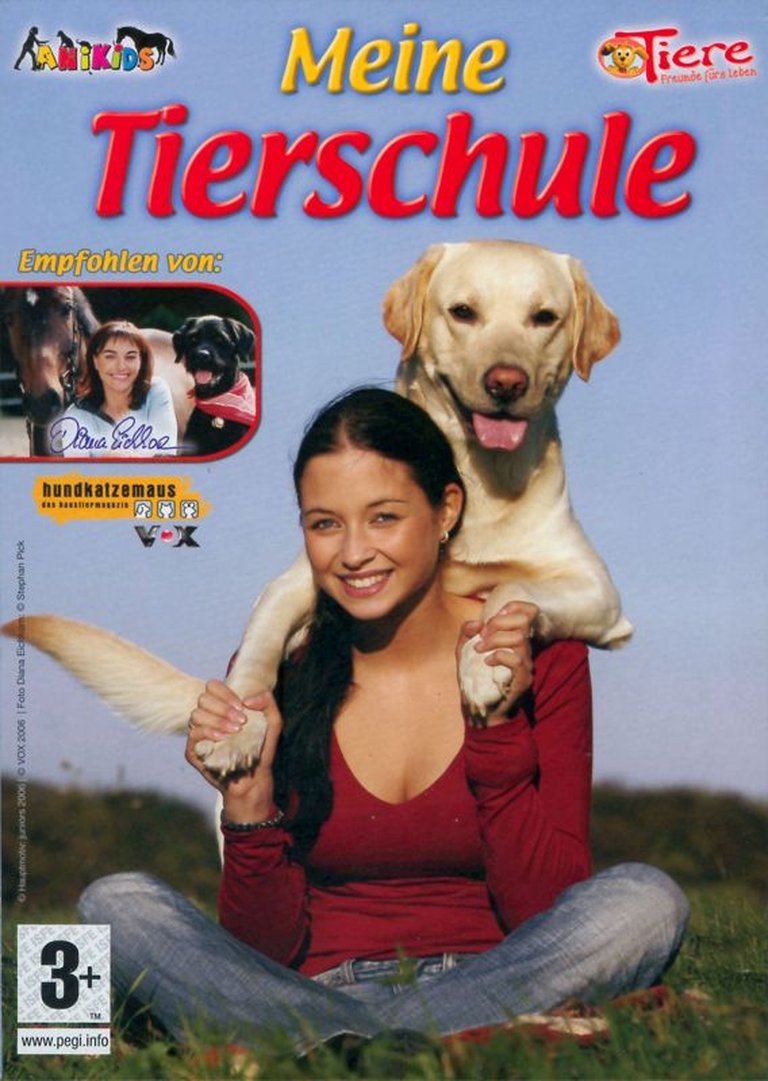- Release Year: 2006
- Platforms: Windows
- Publisher: dtp entertainment AG
- Developer: Radon Labs GmbH
- Genre: Educational, Simulation
- Perspective: 3rd-person
- Game Mode: Single-player
- Gameplay: Animal training, Care-taking, Cleaning, Feeding, Well-being management
- Setting: Countryside, Ecology, Nature, School
- Average Score: 27/100

Description
Meine Tierschule (My Pet School) is an educational simulation game where you take on the role of an animal trainer, teaching various animals from mice to horses different commands and tricks. Set in a countryside compound, you manage kennels, feed and care for the animals, and eventually work with them in the movie industry as your reputation grows.
Meine Tierschule: Review
Introduction
Meine Tierschule (My Pet School) is a 2006 educational simulation game where players take on the role of an animal trainer. The ambitious title offers a blend of pet care, training, and business management. But given its lukewarm critical reception and middling user reviews, does it stand the test of time? Let’s delve into the details.
Development History & Context
Developed by Radon Labs GmbH (known for the Drakensang series) and published by dtp entertainment AG, Meine Tierschule was part of a wave of pet simulation games capitalizing on players’ love for animal interactions. Released in October 2006 for Windows, it later appeared on Nintendo DS in 2007.
Technological constraints of the era meant a focus on 3D graphics with an emphasis on cuteness over realism. The Nebula Device engine powered the visuals, promising:]
But Meine Tierschule had to compete against established pet sims like Nintendogs and Petz, which offered deeper interaction and better AI. Its unique selling point was the promise of working with a wider range of animals and the movie industry angle.
Narrative & Thematic Deep Dive
The game’s narrative revolves around building a thriving animal training school. Players start with a modest setup, teaching basic commands and gradually expanding their facilities and repertoire. The core theme is the bond between trainer and animals, with undertones of responsibility and growth.
However, the plot is minimal, with no engaging storylines beyond the occasional movie contract. The character depth of the animals is limited to their training progress and mood states—happy, hungry, tired—mirroring many petSimulation tropes.
Dialogue is sparse, consisting mainly of training commands and client interactions. The overall mood is light and cheerful, but lacks emotional depth.
Gameplay Mechanics & Systems
At its heart, Meine Tierschule is about training animals through repetition and positive reinforcement. Players interact via a mix of keyboard commands, mouse clicks, and microphone input for voice commands. The training system features a progress bar that increases as animals successfully perform tasks.
Key gameplay features include:
-
Animal Training: Over 20 different commands across species, each with varying levels of complexity. The satisfaction comes from seeing an animal master a new trick after patient practice.
-
Facility Management: Players build and upgrade kennels, training areas, and the main building. Effective layout can improve efficiency, but the impact is subtle compared to more complex management games.
-
* Client Jobs and Reputation*: Completing training tasks for clients increases reputation, leading to higher paying jobs and movie contracts. The financial aspect is simplified, focusing more on unlocking new features than strategic budgeting.
-
Multiplayer Mode: A wireless feature on the Nintendo DS version allows players to compete in training challenges, adding a social layer that was uncommon in educational games of the time.
The UI presents a typical simulation dashboard with icons representing tasks like feeding, cleaning, and training. However, it can be cluttered, especially when managing multiple animals and facilities. The learning curve is gentle, but some systems (like voice commands) can be finicky, requiring precise pronunciation and minimal background noise.
World-Building, Art & Sound
The game’s world is a picturesque countryside setting featuring barns, pastures, and training arenas. The art style is vibrant and appealing, with detailed animal models that display a range of emotions through facial expressions and body language. Each species has distinct visual characteristics, from the scruffy fur of dogs to the glossy feathers of parrots.
The sound design includes realistic animal noises, ambient nature sounds, and a cheerful background score. While the music is forgettable, the environmental sounds help sustain the immersion, making the player feel present in the rural setting.
Reception & Legacy
Meine Tierschule received mixed to negative reviews. The lone critic review from Jeuxvideo.com gave it 25%, citing repetition and slow pacing. User ratings on MobyGames average 2.5/5, indicating some enjoy it but others find it lacking.
The game’s educational value is commendable, teaching principles of animal behavior and training. However, the gameplay can become monotonous as the training tasks are repetitive and offer limited variety. The movie industry aspect is underdeveloped, feeling more like a novelty feature than an integral part of the game.
Compared to peers like Nintendogs and Petz, Meine Tierschule lacks depth in both gameplay and graphics. It’s likely forgotten by most, but could hold niche appeal for those interested in niche pet sims.
Conclusion
Meine Tierschule is a decent entry in the pet simulation genre, providing a whimsical experience of animal training and care. Its visuals and theme are engaging, but the gameplay’s repetitiveness and shallow mechanics prevent it from being a true classic. It’s a product of its time that may charm some, but overall, falls short of its potential.